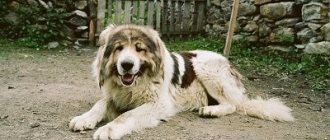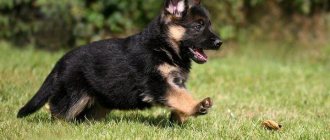Size according to breed standards
The currently accepted breed standards for the German Shepherd imply not only the basic psychological properties of the dog, but also its physical development with the expression of external characteristic features. In improving the quality indicators of the breed, the main emphasis is placed on the presence of the correct anatomical structure in a purebred dog:
- the average height of a dog at the withers, fixed by the standards, for males is about 63 cm, and for females - only 56 cm, but deviations of a couple of centimeters are allowed, and any changes from the average established height significantly reduce the merits of the pet;
- the body length of males varies between 71-77 cm, and females - at 61-70 cm, with the weight of males ranging from 30-40 kg, and females - about 22-32 kg;
- the length of the dog’s forelimbs is necessarily slightly greater than their height, and is about 55-58%;
- the length of the body part of the German Shepherd exceeds the height of the animal at the withers by approximately 110-115%;
- the disadvantage is the presence of a too long or, conversely, excessively short neck, as well as a very small chest area;
- a croup that is too short is unsuitable, and the withers must be long and high;
- the upper part of the head of a purebred dog makes up 50% of its total length;
- The ears and eyes of a German Shepherd are of medium size;
- The ratio of the length of the muzzle to the length of the head should theoretically be 1:2, but often the total length of the muzzle is slightly less than the length of the skull.
The athletic and fairly large build of the purebred German Shepherd should be slightly stretched and above average in size . The bone index for adult German Shepherds should be approximately 18-20 for males, and 17-19 for females. Indicators of proportionality of the chest are also of greatest practical importance.
This is interesting! If the German Shepherd is protected from negative natural and weather influences by a well-developed coat, then the duration of the run and the characteristic appearance are ensured only by the harmony of the animal’s body constitution.
German Shepherd Growth Chart
In puppies of fairly large dogs, which include the German Shepherd, there are two phases of growth processes:
- the stage of skeletal formation is the phase of the most intense growth processes that occur in a German shepherd in the very first months of life;
- The muscle building stage is a phase of slowing growth processes that begins in a pet at five months of age.
Small puppies up to four months of age simply need a colossal amount of energy, which is important for active growth and proper development, but the animal cannot digest a large amount of food, so there is a risk of natural overfeeding of the pet. This is always accompanied by excess weight gain, and also provokes a significant load on all joints, so it can cause severe curvature of the bones, which inhibits growth. As a rule, in five-month-old German Shepherds, the risk of overeating is noticeably reduced, active and correct growth processes occur.
| Age of purebred pet | Growth standards (height at withers) | Chest circumference standards |
| month | 19-21 cm | 29-32 cm |
| 2 months | 33-37 cm | 46-49 cm |
| 3 months | 40-46 cm | 55-59 cm |
| 4 months | 47-54 cm | 60-64 cm |
| 5 months | 51-58 cm | 66-70 cm |
| 6 months | 52-62 cm | 68-72 cm |
| 8 months | 53-63 cm | 70-77 cm |
| year | 55-65 cm | 75-78 cm |
| two years | 55-65 cm | 77-82 cm |
| three years | 55-65 cm | 78-86 cm |
Each owner of a German Shepherd dog must strictly monitor the correct development of his puppy, stabilize the food ration and physical activity, and also systematically carry out control measurements and weighing of the pet.
The height of an adult dog at the withers and rump should be measured with a stadiometer. A tape measure is used to measure the oblique length of the body, girth of the chest and metacarpus, length of the head and muzzle. The compass allows you to measure the depth and width of the chest, as well as measure the width of the skull.
This is interesting! Until the dog reaches six months of age, there are pronounced changes in the height of the withers and the volume of the chest, after which the parameters approach the standard sizes of adults.
German Shepherd Weight Chart
At birth, a German Shepherd puppy weighs only 350-550 g. However, the body weight of individual individuals directly depends on the total number of babies in each litter. Therefore, with a large number of newborns, their weight is noticeably less. In addition, already at birth, the presence of sexual dimorphism is noted, therefore, within one litter, males, as a rule, are noticeably larger than females.
During the very first month of their life, babies feed exclusively on mother's milk, due to which they gain weight very quickly and actively, adding approximately 95-105 g daily. The total weight of a month-old purebred German Shepherd puppy is already about three kilograms.
| Age of purebred pet | Established dog weight standards |
| month | 2.5-4.0 kg |
| 2 months | 6.0-9.0 kg |
| 3 months | 10-16 kg |
| 4 months | 15-20 kg |
| 5 months | 18-26 kg |
| 6 months | 19-28 kg |
| 8 months | 20-32 kg |
| year | 21-37 kg |
| two years | 22-40 kg |
| three years | 22-40 kg |
In the next four weeks of life, a rapid increase in body weight is also observed, and daily weight gain is, as a rule, about 160-170 g. Correctly developed and well-formed four-month-old “Germans” should weigh approximately 15-20 kg.
Return to content
Disadvantages of the breed
A small apartment is not the best place to keep a shepherd.
Shepherds, like other types of canines, have a number of disadvantages, due to which they are often not accepted to participate in exhibitions. The most well-known disadvantages include:
- High level of activity. Such dogs are quite active and because of this, some dog breeders have difficulties with their further training.
- Requires constant attention. Such pets must be carefully looked after and not left alone. You need to walk them outside for several hours every day. This is why experienced dog breeders do not advise people with a sedentary lifestyle to have shepherd dogs.
- Expensive content. Keeping representatives of the German breed is not always cheap. Often you have to spend money on expensive food. People who cannot cope with training on their own have to spend additional money on paying for the services of a dog handler.
- Not very suitable for keeping in small apartments. It's no secret that shepherds are considered quite large dogs. Therefore, they do not recommend keeping them in small houses or apartments. The dog should have enough free space.
- Difficulty in training. Training shepherds is quite difficult. Especially young ones, up to ten months old. Therefore, many people decide to entrust this matter to experienced dog breeders.
The German Shepherd is a popular dog breed that is adopted by many dog owners. Before you buy such a pet, you need to familiarize yourself with the basic parameters of the breed standard, as well as how much money you will need for maintenance.
Deviations from the norm of weight and size
The development of young German Shepherds directly depends on the balance of nutrition and health. A properly selected food ration greatly affects the size of the dog, its appearance and general condition. With the correct proportions of the angles and the body, one can notice sweeping movements running parallel to the surface of the ground, which gives the impression of easily carrying the animal forward.
The greater height of the animal at the withers will entail a noticeable increase in total body weight, which usually occurs at a disproportionately greater level than the increase in muscle strength. As a result, individuals that are too large lack sufficient muscle strength and do not have the necessary endurance and mobility. The smaller height at the withers of the German Shepherd is also not able to provide sufficient muscle strength, so dogs that are too small do not have the optimal area to fix the full volume of muscles.
Important! When choosing food for your pet, it is very important to remember that the bulk of the German Shepherd's weight increases by 20-30% over six months, from the age of seven to twelve months.
Strong deviations from the norm become clearly visible visually, which allows you to call the dog too heavy or light. Both types are considered significant handicaps for the German Shepherd and also significantly limit the dog's typical performance. Among other things, excessive increase and decrease in height often leads to disturbances in the optimal proportions of the build of an adult dog.
Return to content
German Shepherd in motion
When moving naturally, the German Shepherd prefers the type of movement - trot. The limbs move synchronously. With normal proportions of the length of the dog and its limbs, the shepherd dog moves in a sweeping manner, the body in motion is in a parallel position relative to the surface of the earth, while the animal’s head is extended in the direction of movement, the tail is slightly raised. In this position, a smooth line from the ears to the tail should be clearly visible, without any sharp drops or depressions.
How old do German Shepherds grow?
Representatives of German Shepherds are quite large in stature, with a massive build and a strong constitution, and are characterized by later formation. It is for this reason that such dogs in adolescence very often look a little angular in shape, with insufficient proportionality, but acquire complete completeness of all their features in the second or third year of life. Lighter and smaller German Shepherds are usually characterized by early development. As teenagers, such individuals look very elegant and already have a mature appearance.
However, according to the observations of experienced dog breeders, in one-year-old German Shepherds the growth processes in height are completed, but muscle mass continues to increase quite actively. The main peak of development of a purebred dog occurs at the age of three, when such a pet reaches its best physical condition.
Return to content
Service qualities of the German Shepherd
The service (working) qualities of a German Shepherd and its suitability for work are assessed by a special expert commission. In addition to the working qualities of the dog, the commission evaluates its temperament, resistance to stress, psyche and social skills, as well as resistance to artificial stimuli (explosion, shot, car movement, etc.).
In all cases and for any psychological type of shepherd, in order to receive an “excellent” rating, the dog being examined must unquestioningly obey the owner, ignoring the surrounding reality. In addition, it is genetically predetermined that the German Shepherd is obliged to independently make decisions aimed at protecting the owner and protecting the object in case of danger. But even in such cases, the shepherd must remain controllable.
In normal condition, the German Shepherd is calm and balanced. She is obedient in everyday life and does not show excessive aggressiveness towards strangers and living objects. She looks attentive and reserved.
Vices
Obvious visible defects in the German Shepherd, the presence of which determines the exclusion of the dog from participation in genetic selection for the formation of the breed standard:
Obvious disturbances in the behavior, character and psyche of the shepherd dog, as well as excessive phlegmatism or an unbalanced nervous system of the animal, excessive overexcitability of the dog:
- Cowardly behavior;
- Presence of cryptorchidism;
- Underdeveloped testes;
- Discrepancy in the constitution of the dog, violation of proportions;
- Lack of height, short limbs or excessively long legs;
- Deformation of the paws;
- Disturbances in pigmentation of hair and skin;
- Changes in eye color - not dark;
- Excessively elongated muzzle, changes in bite;
- Undeveloped ears, irregular tail;
Origin of the breed
The German Shepherd, considered the national symbol of Germany, is one of the most famous and ancient breeds. It is believed that its ancestors were northern wolves. As a separate breed, “Germans” appeared at the end of the 19th century and earned a reputation as excellent livestock guards and detection dogs.
A huge contribution to the breeding of the breed was made by captain Max Emil von Stefanitz, who later became the founder of the German Shepherd Lovers Club. Painstaking selection work began with herding dogs from the Southern and Central regions of Germany, as a result of which an average type was obtained. This was the dog Greif, the first to be included in the pedigree of the breed.
He was distinguished by his quick reaction, carried out commands better than others and showed good results in grazing livestock. However, due to the dirty coat color, the dog did not fit the definition of a national symbol.
The official date of appearance of the first true German Shepherd is considered to be April 1889. The male Horand von Grafat had impressive dimensions, similar to those of a wolf, and an aesthetic appearance, as well as high quality characteristics. In the same year, the dog, which won an exhibition in Germany, was recognized as the progenitor of the breed. Subsequently, as a result of crossing, several lines of German shepherds were born that fully met the breed's qualities.
The Second World War practically nullified all the work of breeders, and the breed was threatened with complete degeneration. Fortunately, von Stephanitz's followers did not allow this to happen. Today, German Shepherds are very popular and are one of the three smartest breeds.
Features of care
The undoubted advantage of German Shepherds is their ease of care. They are among the unpretentious breeds. For example, you should bathe your pet only 2-3 times a year, since frequent water procedures disrupt the protective layers of the dermis and can cause dandruff. After a walk, it is enough to wipe your paws, clearing them of dust and dirt.
You need to brush the coat once a week, more often during shedding. To do this, it is advisable to purchase a special brush from a veterinary pharmacy. The fur on the paws gets tangled, so it is better to cut it off. The ears are cleaned with a damp swab, the teeth are cleaned with a bone containing fluoride.
"Germans" are very energetic dogs, so it is better to keep them in a private home where they can move freely. If the shepherd lives in an apartment, then you need to walk with it for at least two hours.











